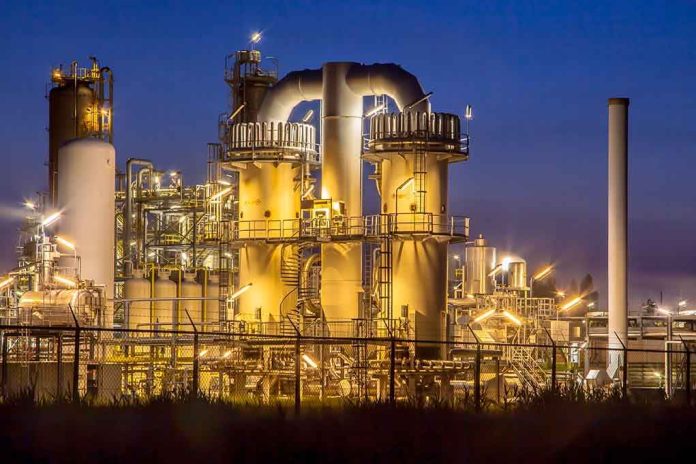
Only in Washington do we watch our “emergency” oil reserves, meant for crises and war, get siphoned off to bail out a private oil giant after a pipeline mishap—because apparently, strategic security takes a backseat to fixing someone else’s contamination blunder.
At a Glance
- The Department of Energy will loan 1 million barrels of oil from the Strategic Petroleum Reserve (SPR) to ExxonMobil’s Baton Rouge refinery.
- The Mars pipeline, supplying key Gulf Coast refineries, suffered from zinc contamination traced to Chevron’s new offshore well.
- ExxonMobil halted acceptance of Mars crude, leading to reduced refinery operations and tighter regional fuel supplies.
- The DOE’s move is framed as a temporary exchange to stabilize fuel markets, but raises serious questions about the purpose of the SPR.
Bureaucrats Dip Into America’s Oil Emergency Stockpile—Again
The Department of Energy will loan up to one million barrels of crude oil from the SPR to ExxonMobil’s Baton Rouge refinery after the Mars pipeline—critical to America’s Gulf Coast—was hit by zinc contamination, thanks to Chevron’s new offshore Ballymore field. The Mars pipeline, operated by Shell and fed by Chevron and others, is the backbone for refineries along the Gulf, supplying the exact type of crude these facilities are optimized to process. When ExxonMobil detected dangerous levels of zinc in early July, they halted Mars crude intake to avoid wrecking their refinery and immediately scaled back production. DOE’s fix? Crack open the emergency reserves, again, not for war or hurricanes, but to patch over a corporate quality control fiasco.
Chevron, meanwhile, confirmed its new well was the source of the contamination, but shrugged off the crisis, saying it would have “no impact” on its production targets. You have to admire the corporate optimism—refineries down, supplies tight, but the show goes on. As for Shell, they’re keeping quiet while the DOE steps in to ensure Louisiana and the Gulf Coast don’t face an immediate fuel crunch. The loaned oil is supposed to be a “temporary” measure, with ExxonMobil returning the barrels—with a little extra—once the mess is sorted. This is what passes for energy “security” in 2025.
A Strategic Reserve or a Private Bailout Fund?
The SPR was created in the 1970s with a single mission: keep the nation running during true emergencies—wars, natural disasters, genuine disruptions that threaten national security. But what do we see today? The government treating this vital stockpile as a revolving credit line for private industry every time someone messes up a pipeline or a refinery can’t get its preferred blend. This is not the first time the SPR has been raided for something less than a national emergency, and each time, the bar for “crisis” drops a little lower. What’s next—SPR withdrawals to cover up accounting errors or supply chain glitches?
The Mars pipeline disruption is serious, no question. Refineries along the Gulf rely heavily on specific crude grades, and with wildfires in Canada and U.S. sanctions choking off Venezuelan imports, there’s been no shortage of pressure on supply. ExxonMobil’s Baton Rouge refinery is a linchpin for regional fuel production, and any sustained outage would ripple through to consumers and businesses. But the fact remains: the root cause was a preventable quality issue, not a hurricane, not a foreign embargo, not a terrorist attack. The DOE’s intervention shields ExxonMobil and, by extension, Gulf Coast consumers from immediate pain—but at the expense of the SPR’s integrity as the nation’s last-resort safety net.
Who Wins, Who Loses, and Who’s Accountable?
ExxonMobil, the immediate beneficiary, gets to keep its refinery humming and avoid multi-million-dollar damage to its equipment. Chevron, whose new well caused the zinc contamination, is under pressure to fix the problem but faces little public scrutiny; their only real penalty is bad press and some technical headaches. Shell, the pipeline operator, stays out of the spotlight, and the government gets to play hero by averting a fuel shortage in an election year. Meanwhile, the American taxpayer sees another chunk of the SPR disappear, with vague promises it’ll be paid back “with interest” later.
For Gulf Coast consumers, the move might stave off price spikes at the pump—at least for now. But what about next time? Each loan and “exchange” chips away at the SPR’s core mission, setting a precedent that could haunt us when a real crisis hits. As for industry experts, many agree that the DOE’s response was proportionate to the immediate threat—but express growing concern over using the SPR for every operational hiccup. If government handouts to giant corporations become routine, what’s the point of a strategic reserve at all?
Sources:
Argus Media: US to loan 1mn bls crude to Louisiana refinery: Update
Energy News (OE Digital): Exxon borrows crude from US emergency stock amid Mars crude issue
The Epoch Times: Energy Department to Give 1 Million Barrels of Oil to ExxonMobil From US Reserves
EnergyNow: Chevron Says Offshore Well Start-Up Caused Mars Crude Quality Issues





